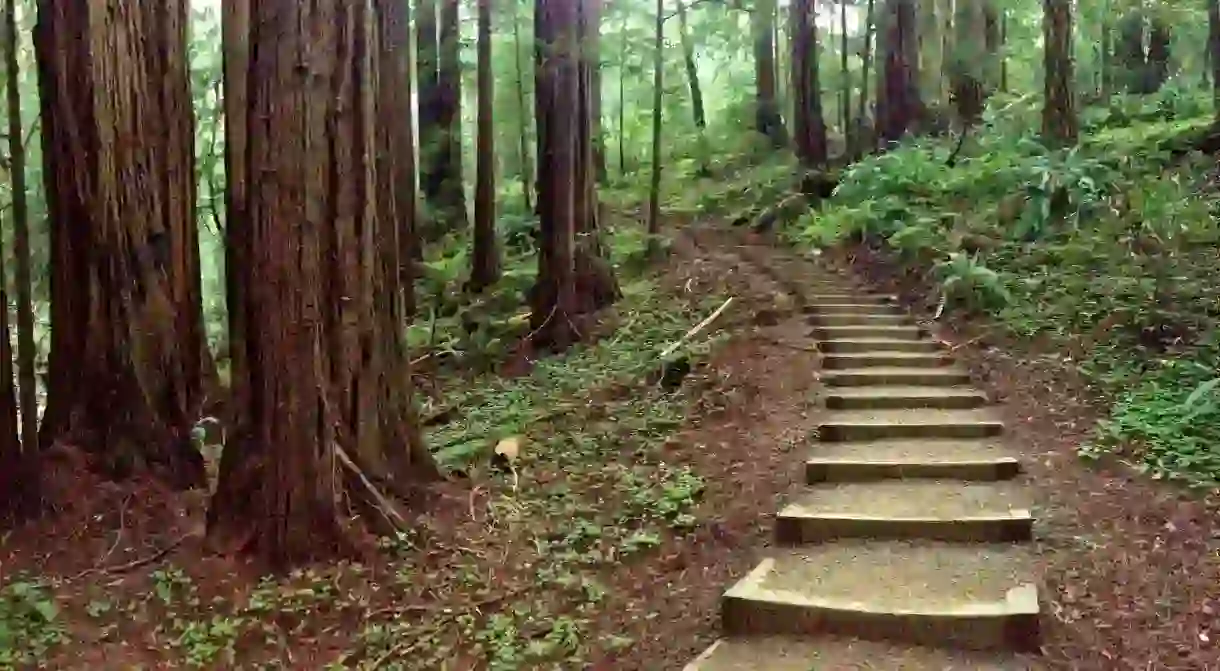Muir Woods: A Guide To The Magnificent Redwood Forest

On the side of Mount Tamalpais, 12 miles north of San Francisco, there stands a glorious redwood forest known as Muir Woods. A proud member of the National Park Service and a National Monument since 1908, this majestic forest is a popular destination for both locals and visitors to hike and explore. Read on to learn everything you need to know about Muir Woods and discover tips for maximizing your visit.
Planning Your Visit
Muir Woods is open every day from 8AM to sunset, but it gets very crowded in the middle of the day, so coming within an hour of opening or close to closing time is always a good idea. Weekdays are less busy than weekends, too. Parking can be tricky – there are two parking lots near the entrance plaza, but they tend to fill up before 9:30AM. After that, visitors can park along Muir Woods Road and walk to the entrance. To avoid parking crises, it’s recommended to come with a tour company, take an Uber, Lyft, or taxi, or take public transportation and hike the last mile. If you’re coming from somewhere in Marin County sometime between April and October try taking the Muir Woods Shuttle straight to the park entrance. Once you arrive, entrance to the woods is $10, or you can purchase an annual pass for $40.

Hiking & Other Things To Do
The main activity on the agenda for Muir Woods visitors is hiking. There are six miles of trails throughout the forest made up of asphalt and boardwalk, including three main trails estimated to take half an hour, one hour, and two hours, respectively. Two of the trails are also ADA accessible. Aside from the forest’s main trails, a variety of longer, more challenging hikes extend from Muir Woods to the surrounding trails of Mount Tamalpais State Park. Strong hikers have options to hike along Fern Creek, explore the Dipsea Loop, or trek all the way out to Muir Beach and Stinson Beach. You can browse through a selection of hikes here before choosing which one is best for you. You can also view a full map of the main and surrounding trails view a map of the main surrounding trails online.
After a day of hiking, grab a bite at the Muir Woods Trading Co. cafe, where you can peruse a display of historic photographs, and maybe pick up a souvenir from the gift shop. You can also explore the Muir Woods Visitor Center at the entrance plaza, where you can learn about redwood ecology and conservation through a variety of exhibits.

The Redwoods
Muir Woods National Monument encompasses a total 554 acres, 240 of which constitute old growth coast redwood forests. Once upon a time, these redwoods and sequoias grew all around the country, but today they only exist in a small strip between Monterey and southern Oregon. The rarity of these forests makes Muir Woods all the more special – the forest’s close proximity to the Pacific Ocean causes it to be frequently doused in fog, allowing the redwoods to avoid drought and creating a consistently wet environment that allows the rest of the forest’s plant life to thrive.

The Animals
Aside from the lush greenery, you can expect to encounter a variety of animals when visiting the woods. The really exciting news for visitors? You can leave your bug spray at home. Muir Woods is host to a very small number of insects. Tannin in the trees repels them, and growth of fruits and flowers that would usually attract insects are limited thanks to the shade of the redwoods. Unfortunately, the lack of insects results in a relatively small number of birds that can survive in the woods, estimated at only about 50 species.
Other animals, however, are thriving under the shade of the redwoods. A variety of mammals have made the forest their home, most of which are nocturnal, but visitors commonly see chipmunks and squirrels as well as the occasional deer or shrew mole. Turn your eyes toward the sky and you might catch a glimpse of a pileated woodpecker or a rare northern spotted owl, and when meandering around Redwood Creek and its lagoon, keep an eye out for various types of salmon, steelhead, and even sea otters.














